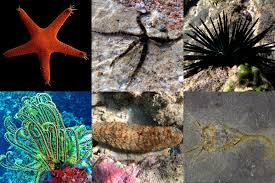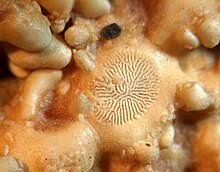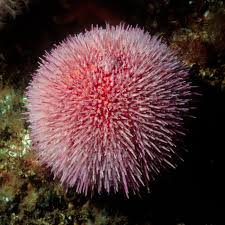Echinodermata literally means ‘spiny or prickly skinned’ (greek, echinos –spiny, derma-skin). They possess an endoskeleton (internal skeleton) of calcareous ossicles (small bones), embedded in skin.
Similarities with chordates:-
(i) They have tube within tube type of body plan which has envolved along deuterostomic evolutionary line.
(ii) They possess a true coelom called enterocoelom.
(iii) They have mesodermal skeleton made of calcareous plates or ossicles.
General characteristic features:-
(1) Habitat:- All enchinoderms are exclusively marine and usually live at the bottom of sea hence they are the bottom dwellers.
(2) Habit:- No parasitic form is found in them. They are the free-living animals.
(3) Body symmetry:- The adult echinoderms are radially symmetrical but their larvae are bilaterally symmetrical
(4) Level of organization:- They possess the organ-system level of organization.
(5) Germ layer:- These are the triploblastic animals.
(6) Segmentation:- Body is unsegmented.
(7) Coelom:- Echinoderms are the coelomate animals.
(8) Body form:- Theadult echinoderms have a pentamerous radial symmetry and their body parts are arranged along the five axes.

Body shape varies from star-like (star fish) to globular or globe-like (sea urchin) to cylindrical (sea cucumber). An endoskeleton of calcareous
ossicles with overlying skin gives a spiny appearance to echinoderms.
(9) Between the spines, there are pincer like structures called pedicellariae to keep the surface clean. Pedicellariae are made of three calcareous plates. Two calcareous valve like structures in the form of jaws resting upon a basal calcareous plate.
(10) water Vascular System:- It is most distinctive feature of enchinoderms. It is fact a modified part of coelom consisting of a system of canals which are filled with watery fluid. Different types of canals together form the water vascular system. It consists of madreporite or sieve plate, stone canal, ring canal, radial canals and tube feet.

Function of water vascular system:- This system is called water vascular system because this system acts like the circulatory system of body maintaining the continuous flow of water in and out of the body.
Phylum Echinodermata
Following are the functions of this system:–
(i) Locomotion:- Most peculiar and interesting role of the water vascular system is in the locomotion. Body is moved by the stepping action of tube feet which are alternatively adhered to and released from the substratum on which the animals move. This happens with the entry and exit of water.
(ii) Capture and transport of food:– The prey is captured and held in position by the arms and tube feet. The food is taken is taken in and then transported in the body.
Autotomy- The ability of starfish to break off a part of its body.
(iii) Respiration:- The tube feet also serve as the equivalent of gills during respiration. The thin walls of tube feet help in the respiratory exchange of gases.
(11) Haemal and Perihaemal System:- Instead of blood vascular system, there are present haemal and perihaemal system which are of coelomic origin. Thus the so called circulatory system is open yype. The so called blood is often without a respiratory pigment. There is no heart.
(12) Digestive system:- Digestive system is complete with two separate openings. It lies along the dorsoventral axis of body. Mouth lies on the lower (ventral) side and anus on the upper (dorsal) side of body
13) Excretory system:- Specialised excretory system is absent. The excretory products diffuse out from the body tissues into the coelomic fluid from where they are finally eliminated out.
(14) Reproduction system:- The echinoderms are usually diocious (sexes are separate). The reproduction is sexual.
(15) Fertilisation:- Fertilisation is usually external, takes place in the sea water.
16) Development:- Development is indirect with free-swimming bilaterally symmetrical larva. (Dipleurula, Bipinnaria, Brachiolaria, Pluteus, Doliolaria, Auricularia).
Example Echinodermata:- Asteris (stsr fish), Pentaceros (star fish), Ophiothrix (brittle star), Ophiura (brittle star), Echinus (Sea-urchin), Echinocardium (Heart urchin), Holothuria (sea cucumber), Cucumaria (sea cucumber), Antedon (feather star sea lily).

